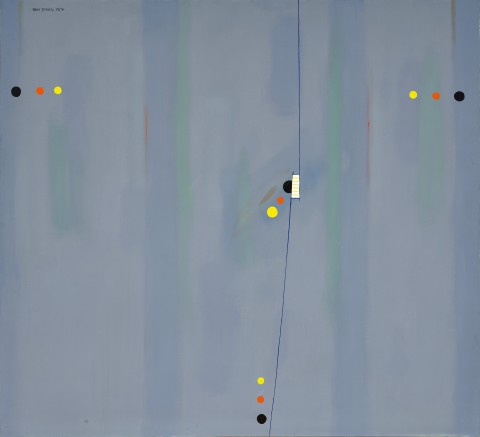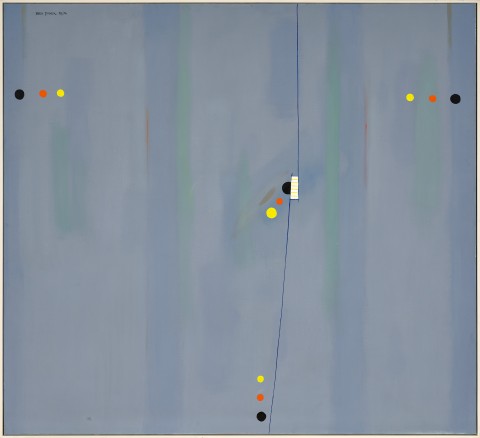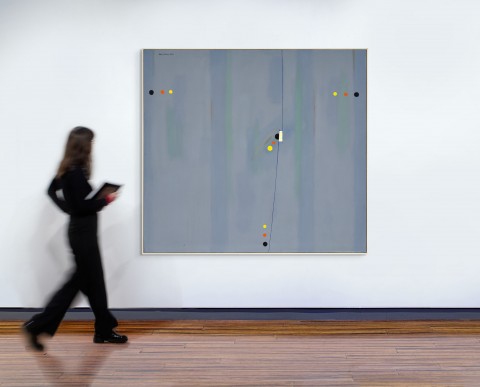(1920 - 1980)
Edwin Tanner
Homage to A.D. Hope, 1975 - 76
synthetic polymer paint on canvas
Estate of Edwin Tanner, Melbourne
Charles Nodrum Gallery, Melbourne (label attached verso)
Private collection, Melbourne
Edwin Tanner Retrospective 1976, Age Gallery, Melbourne, 19 – 29 October 1976, cat. 81 (as 'Plan for the 'Traverse of Mars'. Homage to A. D. Hope')
Edwin Tanner, Charles Nodrum Gallery, Melbourne, 12 – 30 November 2002, cat. 13
Edwin Tanner: Mathematical Expressionist, TarraWarra Museum of Art, Victoria, 12 May – 15 July 2018
Fitzpatrick, A., Edwin Tanner: Mathematical Expressionist, TarraWarra Museum of Art, Victoria, 2018, back cover (illus.), pp. 25, 78 (illus.) 130, 134
Payne’s Grey - the colours that make it, 1975 - 76, synthetic polymer paint on canvas, 167.0 x 183.0 cm, private collection
In June 1967, at the age of 46, Edwin Tanner suffered a chemically induced stroke following the physical effects of a car accident that had taken place many years before. This rapid and debilitating decline in physical health endowed Tanner’s already gnomic art with a melancholy lyricism and a sense of existential reckoning.1 Homage to A.D. Hope, 1975 – 76, balancing an array of Klee-like geometric notation with an expansive field of striated blue hues, belongs to a new series of paintings in Tanner’s oeuvre. Pushing the limits of abstraction in his oeuvre, and in keeping with the predominant formal approaches of the time, namely Colour Field painting, these works presented a rare instance of Tanner interacting with mainstream artistic styles.
A remarkable polymath, Tanner’s eclectic and diverse career progression and broad range of intellectual achievements informed his often-autobiographical paintings, including motifs from engineering, maths and aviation to philosophy and poetry. In 1970, the physical ramifications of his stroke not only forced him to resign from engineering but also put him in hospital for a period in August 1973. It was during this period of convalescence where Tanner made a series of sketches based on his childhood home in Wales, providing the aesthetic stimulus for a new suite of paintings: a schematic aerial depiction of the house and its adjoining roads, a motif that appears in the centre of Homage to A.D. Hope.2 Although Tanner emigrated to Australia with his family as a small child, he never felt fully assimilated. The artworks from this late series reflect the artist’s observational distance and sense of cultural and physical dislocation, their emotive quality hidden in plain sight. The first work of the series, Emigration, 1973 (private collection) featured a cluster of semi-circular forms orbiting the house’s central axis. While Emigration explicitly referenced the artist’s peregrinations, other works, such as Homage to A.D. Hope, particularly with its additional title ‘Plan for the Traverse of Mars’, express a more expansive movement of particles through negative space, a luminous and airy plane.
Homage to A.D. Hope presents a hard-won harmonisation between Tanner-the-engineer and the artist’s deep metaphysical, literary and poetic sensibilities. The colour modulations of his minimal backgrounds and the cheeky personal humour of his stylisation reveal a portrait of this artist in his astounding multifaceted complexity. Tanner was particularly attuned to the ancient links between poetry and painting. Joining paintings dedicated to authors T.S. Eliot, Aleksandr Solzhenitsyn, Ludwig Wittgenstein and references to Shakespeare and Shelley, here Tanner pays homage to a friend, the Australian poet and professor Alec Derwent Hope, OBE. While Tanner had his own poetry published in journals Overland and Quadrant, his connections to this rarefied literary milieu came primarily through his long and close friendship with the Tasmanian poet Gwen Harwood, regarded as one of Australia’s finest poets. Writing a poignant text of personal memories for Edwin Tanner’s retrospective exhibition at Monash University Gallery in 1990, Harwood related the artist’s reflection in 1970: ‘It is clear now that my best work has an elegance and opalescence of some kind – some detachment and wit. Now with relief from pain I am working with all the determination and deliberation that spontaneity really needs i.e. first-rate spontaneity not slapstick.’3
1. Fitzpatrick, A., Edwin Tanner: mathematical expressionist, TarraWarra Museum of Art, Victoria, 2018, p. 129
2. ibid., p. 23
3. Harwood, G., Memories of Edwin Tanner, Monash University Gallery, Victoria, 1990, p. 4
LUCIE REEVES-SMITH


